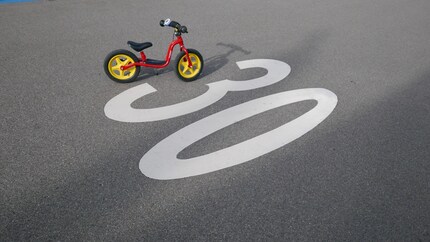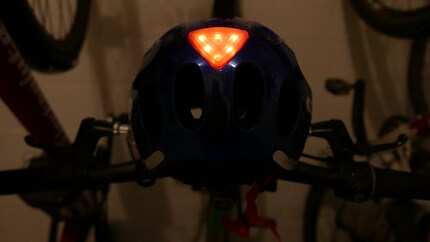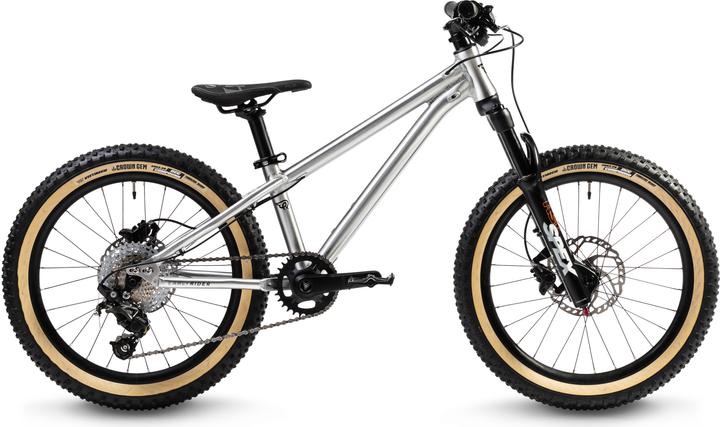

Start small, make it big: From balance bikes to children's bikes
Becoming mobile themselves is a big moment for children. With the right bike at the right time, you can encourage them without overtaxing them. Most children learn to ride a bike easily - and without training wheels.
In the beginning there was the pram. The baby slept, you pushed and had everything under control. Barely two years later, you're already panting behind at a running pace. Your child has discovered the bike and is getting more and more into it. You should let your child take small steps so that the start to a mobile life is easy for them. Having their own bike is a reliable source of enthusiasm, but it also presents your child with a difficult task. If they are not yet ready or the bike is too big, the well-intentioned purchase will initially cause frustration.
Wheel instead of training wheel
Less is more when it comes to finding your balance. A balance bike is the perfect vehicle for training a sense of balance from an early age. Your child has a secure footing and will start off doing exactly what the name says: running on the bike. The first attempts have nothing to do with riding. But then comes the moment when they realise that they can do more. The steps get longer, the wheels turn faster.
The child rides and has the security of being able to put their feet on the ground at any moment without the need for pedals. It is faster and more manoeuvrable than on a bike with training wheels. It also learns to lean into bends. In short: after a while, they will have mastered almost everything they need to ride a bike.
Wheeled bikes are generally suitable from a height of +/- 90 centimetres and have twelve-inch wheels. A convertible model such as the Wishbone 3 in 1 Bike is ideal for the very youngest - it can also be used as a tricycle at the beginning. The Kokua Jumper from LIKEaBIKE also absorbs bumps on bumpy roads with its rear swing arm. Even the little ones can manage longer distances on the balance bike and the step to the bike is very small. [[productlist:6820429,363315,367539]]
To all balance bikes
If you are missing a brake, there is also one, for example on the Puky model. My children were fine with them until they switched to bikes. In hindsight, however, I could have done without the brakes. 99 per cent of the time, my children preferred to push their legs into the ground and brake with their feet. The cable was also a disruptive factor because the children like to twist the handlebars.

The step to the bike
Many children make the switch to bikes straight away. After all, they have trained their sense of balance on a balance bike, learnt how to corner and developed a basic sense of speed and braking distances. Now they can concentrate fully on pedalling, which works quickly with a little help. Starting off on their own is a bigger hurdle, which experience has shown requires a few more attempts. When riding, the child's eyes tend to wander down to the pedals - so a safe, large and, if possible, deserted practice area is a must. To ensure that the child can cope with the new challenge, the proportions of the bike must fit their body mass.
Important factors
Crotch length (inside leg length):
The child should sit on the bike in such a way that both legs can safely touch the ground. The inside leg length is crucial for this. You can measure it on any wall if you have a book and a tape measure to hand. The child clamps the book between their legs as if it were a saddle. You measure the distance between the top edge of the book and the floor and note the stride length. You will find information on the recommended (minimum) stride length in each product description.
Body size:
It is also important that your child's height is within the recommended range. The bike size and frame geometry must match your child's height. Then they will find a comfortable riding position and be able to steer and brake safely at all times. A frame with a low step-through makes it easier to get on and off the bike. This is extremely helpful, as many falls happen when travelling slowly or when trying to stop. Children have to keep control of a vehicle that is about half as heavy as they are.
Toy or vehicle?
The question of when a child is allowed to ride which bike where is more complicated than expected. When is the pavement the right place? When is the road?
- In order to be able to ride on the road, the frame size must correspond to the child's height and the bike must be safe to use. You can ensure this by paying attention to the points mentioned above.
- Children's bikes are designed for children of pre-school age and are classed as "vehicle-like devices (FäG)". This puts your child on an equal footing with pedestrians and allows them to ride on the pavement, on cycle paths or in pedestrian zones, for example, until they are six years old. Playing on the carriageway is also permitted in low-traffic side roads, 30 km/h speed limits and pedestrian zones.
- Children under the age of six may also ride on main roads if accompanied by a person aged 16 or over.
- From the age of six, the same regulations apply as for all bicycles: the equipment must be suitable for road traffic and the pavement is a no-go zone unless otherwise signposted.

No one can expect six-year-old children to be fully roadworthy. Accordingly, there is a certain amount of room for manoeuvre here - both for parents and for law enforcement officers. Pro Velo Schweiz has found that children are only able to cycle safely and independently in traffic at the age of ten to twelve. In the brochures "Kind und Velo" and "Children playing and cycling on the road" you will find all relevant information on the topic.
14 inches: the intermediate step
The smallest step from a balance bike to a bicycle is a 14-inch bike like the Buttons from Royalbaby. It makes sense if your child is still quite small but already ready for a bike in terms of coordination. The Buttons is recommended from a stride length of 35 centimetres and a height of 95 centimetres. With the closed chain case, it is safe and your child will quickly master the transition from the balance bike. You can safely ignore the training wheels supplied.

As children grow quickly in the first few years of their lives, the 14-inch bike will soon be too small. My son put it in the corner after one season and grabbed his sister's 16-inch model. It's a misconception that a smaller bike should always be lighter. The 14-inch model was significantly heavier for us. And at 9.6 kilograms, the Buttons also weighs much more than the 16-inch Belter from Early Rider with its 5.9 kilograms.
16 inches: Ready for first tours
With this size, cycling fun really starts and longer tours are soon possible. A bike that is as light as possible is worth its weight in gold for children and significantly increases their riding enjoyment. This is one of the reasons why the bikes from Early Rider are so popular, even though they are not cheap. In return, you get a bike whose components are absolutely high-quality and suitable for children. With the belt drive, it is virtually maintenance-free, you only have to check the rim brakes from time to time and readjust them if necessary.
To keep it light, everything that is not absolutely necessary has been omitted. For example, a stand is not fitted. A gear shift is also not yet useful on the 16-inch bike. For climbs and rides on main roads, I would opt for a tandem bar or a FollowMe clutch.
20 inches: shifting becomes a topic
At some point around the time they start school, your child will grow into the 20-inch segment, i.e. be around 115 centimetres tall and reach a stride length of 50 centimetres. Their new bike should still be light and have child-friendly components. It also makes sense to have gears now. It took my daughter a few weeks before she was able to safely operate the 3-speed hub gears of the Early Rider Urban while riding. I think three gears are enough for now. With these three gears, it also manages steeper climbs and the hub gears are low-maintenance compared to derailleur gears. The fact that the Sturmey-Archer hub cannot be combined with the belt drive for technical reasons is the only small downer on a great bike.
At this age, the number of gears is hotly debated on the playground and derailleur gears are constantly cracking in search of the "right" gear ratio. A 9-speed derailleur and hydraulic disc brakes, such as on the Hellion from Early Rider, are particularly useful if the bike is actually taken off-road on a regular basis. Forest paths and climbs are also no problem with the more urban bike and hub gears.
From the age of six, the "vehicle-like device" legally becomes a real bicycle that belongs on the road and must be equipped as follows:
- Pumped tyres
- 2 powerful brakes
- Reflectors at the front (white) and rear (red), each at least 10 cm2 in size, and on the pedals (orange; not necessary for racing bikes)
- At dusk, at night and in tunnels: a static light at the front (white) and rear (red). Additional flashing lights are permitted.

Zu den Kinderhelmen mit integriertem Licht
24 inches: The largest children's bikes
When your child gets older and is perhaps already regularly travelling alone by bike in their everyday life, the equipment is important. A bike like the Mustang Trailchecker SL has everything that can be useful and promises safety, from the lighting system and mudguards to the pannier rack.
A bicycle bell and a saddle are no longer mandatory since 15 January 2017 - but both are very useful in everyday life. 😉
This article was updated, first published on 21/08/2019
Simple writer and dad of two who likes to be on the move, wading through everyday family life. Juggling several balls, I'll occasionally drop one. It could be a ball, or a remark. Or both.
Practical solutions for everyday problems with technology, household hacks and much more.
Show all






